On Thursday, May 24, the Broad Museum was infiltrated by a coven of four Latinx she-monsters wearing wigs on their faces, jeans tossed around their shoulders, and topless fake-hair onesies. In the Broad’s foyer, they appeared in the midst of a luxuriously-dressed LA crowd. They commenced the action by wandering about aimlessly. They nudged up against the spectator’s bodies. They started crawling on the ground. They tried to put on their jeans, and thrashed around when the pants wouldn’t fit right. They gathered together in a little huddle and sang, louder and louder, until they were screaming and nearly vomiting. Then one of the enchantresses grabbed her jeans and ran up to a wall didactic explaining the Broad’s current blockbuster Jasper Johns retrospective. She flagellated Johns’ name with her pants while the crowd started cheering. After that, all of the women erupted into a frenzy of jeggings-whipping and more floor-writhing.
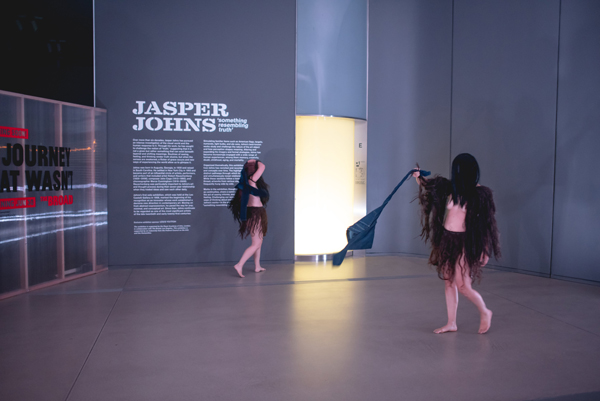
This was Uruguayan/Brooklynite choreographer luciana achugar’s FEELingpleasuresatisfactioncelebrationholyFORM, the opening act of the Broad’s exciting and continuing En Cuatro Patas (on all fours) program of feminist Latinx performance art. Curated by LA-based performance artist and filmmaker Nao Bustamante and Oakland provocatrix Xandra Ibarra, the happening possessed the astringency of home truths. Bustamante, later appearing before the audience, explained that the theme of the evening was “the corporeality of abjection.” Yet, when the hairy sorceresses had started hyperventilating and droolingly grunting at each other, their gesture seemed like a fair recreation of the conversations I have about DACA abolition and Planned Parenthood defunding with my colleagues at work every morning.

The corporeality of abjection – in other words, “in yo face.” The short videos that provided the show’s second act generated revelations about how unleashed official racism and patriarchal rule-of-lawlessness dismantle women of color’s bodies. Peruvian movement artist Amapola Prada’s film 2014 showed her tied to a fence while wearing a school uniform and a black, eyeless head-sock, and trying to run repeatedly toward the observer. Dominican-American Joiri Minaya, in 2002’s Satisfied, sits in her underwear at a kitchen table and crams fake dead mice in her mouth until she gags. In her undated Binólogo #1 (Nest / Nido), she may be healing herself as she drinks clear water witched from a bird’s nest that she discovers on a naked man’s crotch.
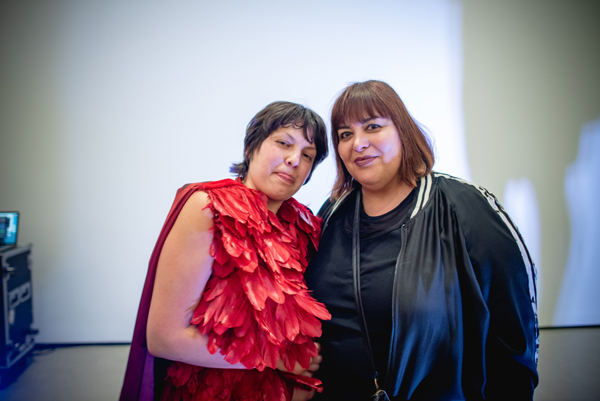
Longstanding collaborators Abigail Severance and Julie Tolentino’s petrifying evidence revealed a woman getting her bottom “cupped” not by a lover but by a handyman affixing glass bulbs all over her hind quarters. Mickey Negron’s coruscating PonerMickeytarme: Ritual de pluma y purificacion (nd) displays Negron with a mustache, tight pectorals, and shapely round bottom. They douse themselves with honey and feathers while standing amid a crowd of churchgoers attending a religious event. The film sways between horror, while women scream at him and seem ready to commit violence, to jubilation, as several people lovingly approach Negron and give them urgent hugs.
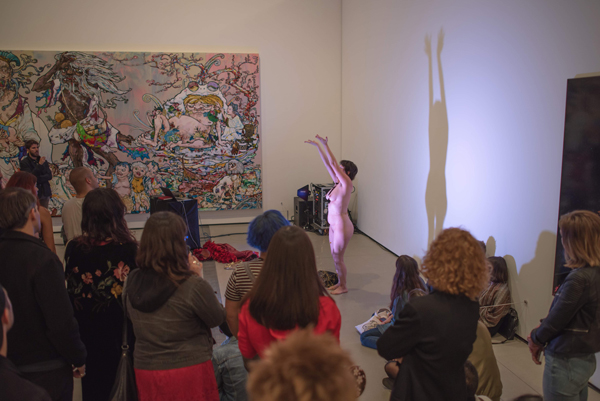
Xandra Ibarra’s Fuck My Life appeared constructed around the body abjection thesis: Ibarra is a critical race burlesque performer who makes “spic-tacles” that work to defeat the white gaze, but fail to do so – so, “FML.” Ibarra’s narrative began with a striptease performer waking up in bed makeup-smeared and hosting a Magic Wand between her legs. Her morning’s highlights find her scuttling around her apartment swilling bourbon and peeing before dressing up like a huge golden cockroach and running away. Ibarra’s work laments her inability to create teachable lessons, but her star quality remains so incandescent that her efforts to be corporeally abject fail. Watching her bash lipstick into her face I wondered about the epigenetic utility her kind of glamour distributes – it’s not just beauty; it’s a Marilyn Monroe/Lupe Velez halo that hijacked Ibarra’s dour message and seemed to possess as its greatest purpose the inducement of dangerous scopophiliacs to bow down.
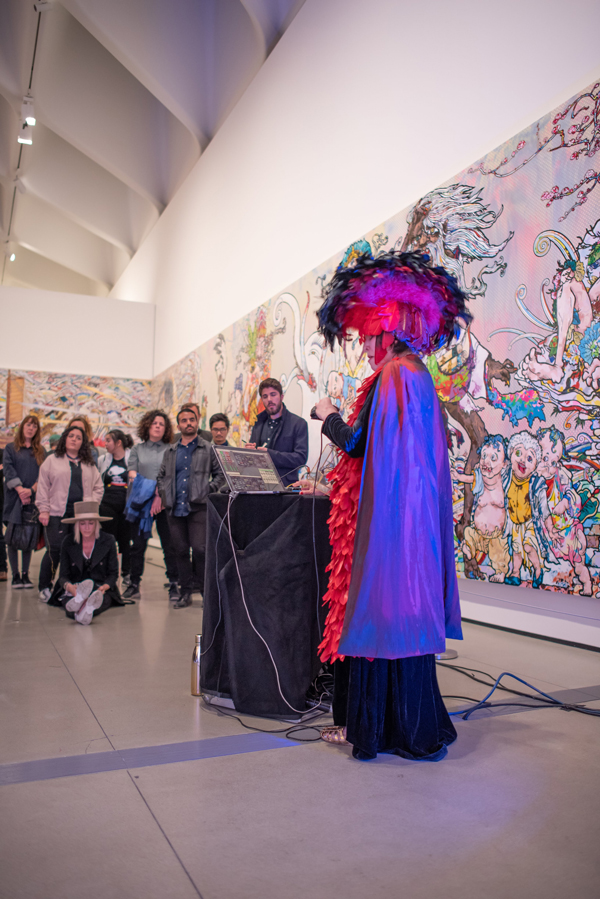
Carmina Escobar’s fabulous Passer embodied not abjection, but nature, the forest, technology, and the cosmos. Escobar, a renowned voice artist, appeared on the Broad’s third floor dressed in red feathers, a black velvet gown, gold shoes, and a necklace with a huge glass pendant that contained balls made of copper twine. She assumed the mantle of Ovid’s Philomela, whose voice was torn away by Tereus and restored by the gods when they transformed her into a nightingale. Escobar’s excellent vocal range ascended to a tinnitus-like pitch, which she modified with a machine so that it echoed back and then distorted into the crashing sounds of computer malfunction. Escobar took out the little copper twine-balls from her pendant and put them in her mouth, unspooling the threads with her fingers. She affixed them to a ceramic mushroom and gave the free ends to audience-members, who all seemed to love what was going on.

After that, Escobar passed out little colored slips of cellophane. She took off her robe, stood before us completely naked, and called upon the people with the cellophane to rub it with their hands. A magical sound like rain fell from the air, combining with the music that had now softened from industrial noise to harmonic convergence. Escobar closed her eyes, raised her hands, and conducted the music made by the cellophane. The ingenuity of this symphony made her a conductor more formidable than Dudamel. And its beauty gave observers the strength to grapple with the deep sadness of the other artists’ work, rather than succumbing to their terrifying message that the current nightmare is actually our waking life and there may be no way out of it.
The Broad’s En Cuatro Patas continues on Thursday, Oct. 11, and Thursday, Nov. 15.
Photographs by Ben Gibbs





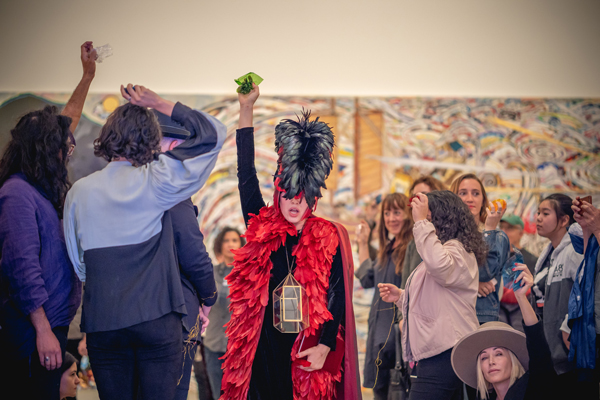













0 Comments